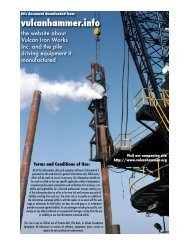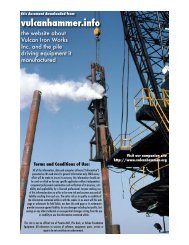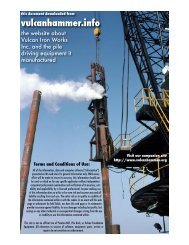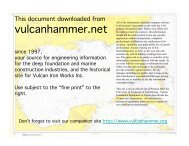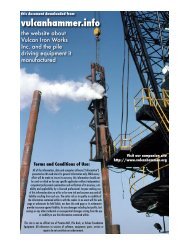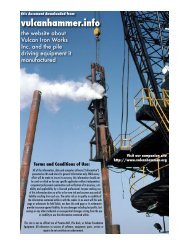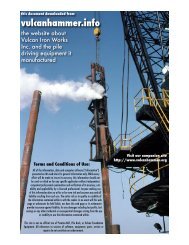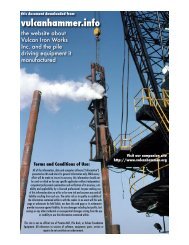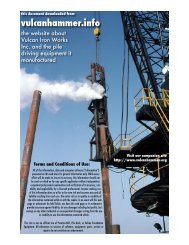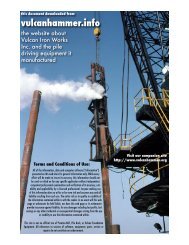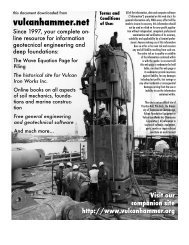Dynamic Prediction of Pile Static Bearing Capacity - vulcanhammer ...
Dynamic Prediction of Pile Static Bearing Capacity - vulcanhammer ...
Dynamic Prediction of Pile Static Bearing Capacity - vulcanhammer ...
Create successful ePaper yourself
Turn your PDF publications into a flip-book with our unique Google optimized e-Paper software.
w-cipal objcctivc <strong>of</strong> the prcsent work, since C, cnnstfti~tcs the stntic ljcnrlngcapacity <strong>of</strong> thc pile.FTELD NOilKIn the course <strong>of</strong> other portfons (see ilcf. 3) <strong>of</strong> thr project <strong>of</strong> which thepresent study was a central part, a number <strong>of</strong> steel pipe tcst piles, both fullscaleand rctlucc4-scale, were first driven and subsequently load testedstaticallv.D-dring the driving two kinds <strong>of</strong> dyn~mic irformation were measured~accelcration,and strain n e a m P <strong>of</strong> the pile. Details <strong>of</strong> the instrumentationa-vcn in Rcf. 8 and in Appendix 11. Essentinlly, a pirzoclcctric accezrom e r 2nd foil resis!ance strain gages werc r~lourited on t!ic sides <strong>of</strong> the ailenear its top. lllclr processed and rccodcd clcctrical output versus timeduring-a hnmrner blow constituic ttic main i!iput dntn <strong>of</strong> the present study.Ezan:piZToT-tfie rcsult~rz harnmr~. forcc vreti:llr curves obtnincn by Thismethod arc shown for five example pilcs ir, Fir. 2, 1;igs. 3 t!irougli 7 conhintfie corresponding measured ncccleration records. (Other tlnta are also prcsentin these fipres, as will be discusse~i :~t a 1::trr I?oi~lt.)Dah on pile static testing are detailed in Ref. 8':1nd discussed briefly inAppendix Ill. At the present point, it suffices to 11otc that stntic testing ..v:lscarried out by two different loading mctlioc!~, b~th <strong>of</strong> \ihicli gave essentiallythe same ultiinate, or failure, load <strong>of</strong> the pile. These mcti~ods ::lay be brieflyidentified by the tcrms "constant rate <strong>of</strong> penetr:itionn (CI;1)) and "mnintaineciload" (ML) test. Since it is on!y the ultirnnte load which is 1)rcscntly <strong>of</strong> intcrest,m s i s on pnr!iculxr aspects <strong>of</strong> st:\:ic load testing is omitted. Detailcd'dormation on this is reported in Refs, 8 and 9.. .1-1 tho t1111~ I ntcrvaibekeen obtnining nicnsurcd d ~ n d nt? m o! nccclcrntiori and hammer for=----.-.- end <strong>of</strong> driving and performance <strong>of</strong> x st;i!ic 1raii test iviu reduced to aminimum <strong>of</strong>s~y-._n-few hours. For cascs ufl~crc n 'sct-up* time after initial&ving has occurred, a static load test was jri-fo:-r>ic.c! f i s :\rid IV-.-I:r ~Rer ~oT.i?il~-n~-t>e :ibove stateti dviiu&-cc~I>t:iinetl.Soilconditions surroundinrrthc tesi 'lcs tliscussc~tl in :i!~s pn])cr are s -i,cificdin Appendix D!. 65~2'w~~~,--U--The aim <strong>of</strong> the study herein rcywrtcd is to 1--ctiict, tiirouyh the use <strong>of</strong> t11~analytical model prcscntcd, the static bcnriny; c:~l)azity <strong>of</strong> t!:e tcst piles fromthe d;.namic mcasurerncnts allutfcd to nbovc. Tile nlct:ioci for doing ttiis 1.viilnow be outli~ed.fiaJ.&k- -*C.*as usable. Ttrc damping ratio t; w:is takc~r as large: t, = 0.0 and was \.aricdvcrs little from this valuc in all calculations. The time I, was taken near thevalue t/c, tliough not esnctly at this valt~c, but iii the case <strong>of</strong> a full-scale pileat3 value close to [lip time <strong>of</strong> thr mnximum measured velocity response. Themcasurcd value for thr speed <strong>of</strong> sound in steel which was uscd was c = 17200fps. For better match <strong>of</strong> predicted and mcnsurcd velocity response it wasfound convenient to vary t, slightly.The computer-aidcd procedure then used was as follows: give11 the measuredforce input and the tt~cory developed in .4ppcndix 1, the best possiblcnintch between the theoretical and measured p!le displacement was soughtusing ally reasonable values for the iour pnranleters mentioned. The niensureddisplacement was obtained through double integration <strong>of</strong> the measuredaccelcr:lt~on. Oftcn an internlediatc aid in determining a good displacementmatch was to brin:: comixltcd velocity peaks !nto agreement with e.xperfmentaloncs. When 'best" matchxvas judgcd tobc obtained, the correspontling valueTYPE STEEL PIPEDlAM J INCHESSECTlOt< ASEA 170 IN'LENGTH 12 FTULT STATIC TEST DCAHitlGCAPACITY 9 5 KIPSY.I ' !-----JCALCULA7lOlJ PARLMETERSANALYSIS PROCEDUREFour parameters were chosen as \,arl3lJlC for regulating thc ;~nalytical pilemodel. Tllese are (see .4ppendlxI): Co, the cat-th rcslstnncc along the sides <strong>of</strong>:he pile; KO, a soilshenr resistance p~mmetcr; i, the damping ratio <strong>of</strong> longixdinalelastic modes in t;he pile undcr the assumtd resistance law; and I,,?ominally the time for pile-top velocity to rcach its rnz~iniu:n. Of these p-ranreters, C, proved by far the most important, lhr othcrs l~clng 'trimming"ximmetcrs only. [choosing KO = 0, t = 0.9, 1, = 1-/r (or nltrrnntely 1, = timeo rcach pcak velocitv) would effectively remove these t rininiing pnrsnletersrom further consideration.] For example, .llmost an). rr.iscp;lbIc valuc <strong>of</strong> I;,,- THEORETICAL--- MEASUREDTlhlE If.( MILLISECONDS



